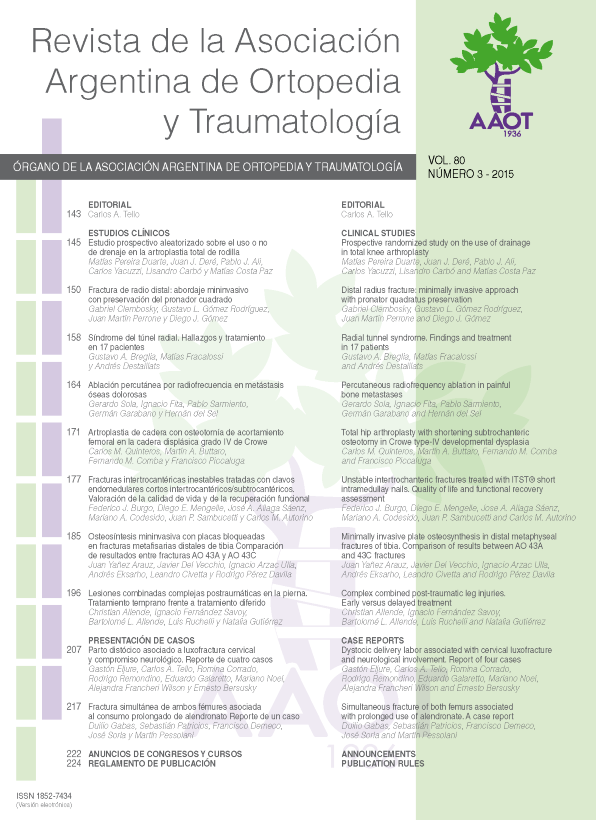Percutaneous radiofrequency ablation in painful bone metastases
Main Article Content
Abstract
Downloads
Metrics
Article Details

This work is licensed under a Creative Commons Attribution-NonCommercial-ShareAlike 4.0 International License.
Manuscript acceptance by the Journal implies the simultaneous non-submission to any other journal or publishing house. The RAAOT is under the Licencia Creative Commnos Atribución-NoComercial-Compartir Obras Derivadas Igual 4.0 Internacional (CC-BY-NC.SA 4.0) (http://creativecommons.org/licences/by-nc-sa/4.0/deed.es). Articles can be shared, copied, distributed, modified, altered, transformed into a derivative work, executed and publicly communicated, provided a) the authors and the original publication (Journal, Publisher and URL) are mentioned, b) they are not used for commercial purposes, c) the same terms of the license are maintained.
In the event that the manuscript is approved for its next publication, the authors retain the copyright and will assign to the journal the rights of publication, edition, reproduction, distribution, exhibition and communication at a national and international level in the different databases. data, repositories and portals.
It is hereby stated that the mentioned manuscript has not been published and that it is not being printed in any other national or foreign journal.
The authors hereby accept the necessary modifications, suggested by the reviewers, in order to adapt the manuscript to the style and publication rules of this Journal.
References
2. Dupuy DE, Goldberg SN. Image-guide radiofrequency tumour ablation: challenges and opportunities. J Vasc Interv Radiol
2001;12:1135-48.
3. Mercadante S. Malignant bone pain: Pathophysiology and treatment. Pain 1997;69:1-18.
4. Di Francesco A, Flamini S, Zugaro L, Zoccali C. Preoperative radiofrequency ablation in painful osteolytic long bone metastases.
Acta Orthop Belg 2012;78:523-30.
5. Thanos L, Mylona S, Galani P, Tzavoulis D, Pomoni M. Radiofrequency ablation of osseous metastases for the palliation of
pain. Skeletal Radiol 2008;37:189-94.
6. Moser T, Goyault G, Gangi A. Image-guided ablation of bone tumors: review of current techniques. J Radiol 2008;89:461-70.
7. Link TM, de Mayo R, O`Donnell RJ. Radiofrequency ablation–an alternative for definitive treatment of solitary bone metastases.
Eur Radiol 2007;17:3012-3.
8. Pagelopoulos PJ, Mavrogenis AF, Galanis EC, Kelekis NL, Wenger DE, Sim FH, et al. Minimally invasive techniques in
orthopedic oncology: radiofrequency and laser thermal ablation. Orthopedics 2005;28(6):563-8.
9. Dupuy DE, Liu D, Hartfeil D, Hanna L, Blume JD, Ahrar K, et al. Percutaneous radiofrequency ablation of painful osseous
metastases: a multicenter American College Of Radiology Imaging Network trial. Cancer 2010;116:989-97.
10. Gazelle GS, Goldberg SN, Solbiati L. Tumor ablation with radio-frequency energy. Radiology 2000;217:433-66.
11. Rosenthal DJ, Hornicek FJ, Torriani M. Osteoid osteoma: percutaneous treatment with radio-frequency energy. Radiology
2003;229:171-5.
12. Goetz MP, Callstrom MR, Charboneau JW, Farrel MA, Maus TP, Welch TJ, et al. Percutaneous image-guided radiofrequency
ablation of painful metastases involving bone: a multicenter study. Clin Oncol 2004;22:300-6.
13. Mirels H. Metastatic disease in long bones. A proposed scoring system for diagnosing impending pathologic fractures. Clin
Orthop Relat Res 1989;249:256-64.
14. Frassica DA. General principles of external beam radiation therapy for skeletal metatases. Clin Orthop Relat Res 2003;415:158-64.
15. Marchal F, Brunaud L, Bazin Ch, Boccacini H, Henrot P, Trofleau P, et al. Radiofrequency ablation in palliative supportive care:
early clinical experience. Oncology Reports 2006;15:495-9.
16. Bauman G, Charette M, Reid R, Sathya J. Radiopharmaceuticals for the palliation of painful bone metastasis—a systemic
review. Radiother Oncol 2005;75(3):258–70.
17. Mannion RJ, Woolf CJ. Pain mechanism and management: a central perspective. Clin J Pain 2000;16:144-56.
18. Honore P, Luger NM, Sabino MAC. Osteoprotegerin blocks bone cancer-induced skeletal destruction, skeletal pain and painrelated
neurochemical reorganization of spinal cord. Nat Med 2000;6:521-8.
19. Callstrom MR, Charboneau JW, Goetz MP, Rubin J, Wong GY, Sloan JA, et al. Painful metastases involving bone: feasibility of
percutaneous CT and US guided radiofrequency ablation. Radiology 2002;224:87-97.
20. Callstrom MR, Charboneau JW, Goetz MP, Rubin J, Atwell TD, Farrell, et al. Image-guided ablation of painful metastatic bone
tumors: a new and effective approach to a difficult problem. Skeletal Radiol 2006;35(1):1–15.
21. Sherif GN, Aschoff AJ, Mitchell IC, Emancipator SN, Duerk JL, Lewin JS. MR imaging-guided radiofrequency thermal ablation
of the lumbar vertebrae in porcine models. Radiology 2002;224:452–62.
22. Dupuy DE, Hong R, Oliver BS, Goldberg SN. Radiofrequency ablation of spinal tumors: temperature distribution in the spinal
canal. Am J Roentgenol 2000;175:1263–6.
23. Buy X, Basile A, Bierry G, Cupelli J, Gangi A. Saline-infused bipolar radiofrequency ablation of high-risk spinal and paraspinal
neoplasms. Am J Roentgenol 2006;186:322–6.

